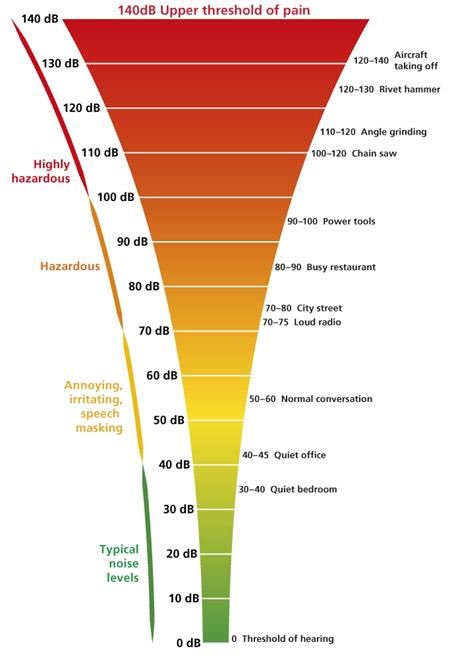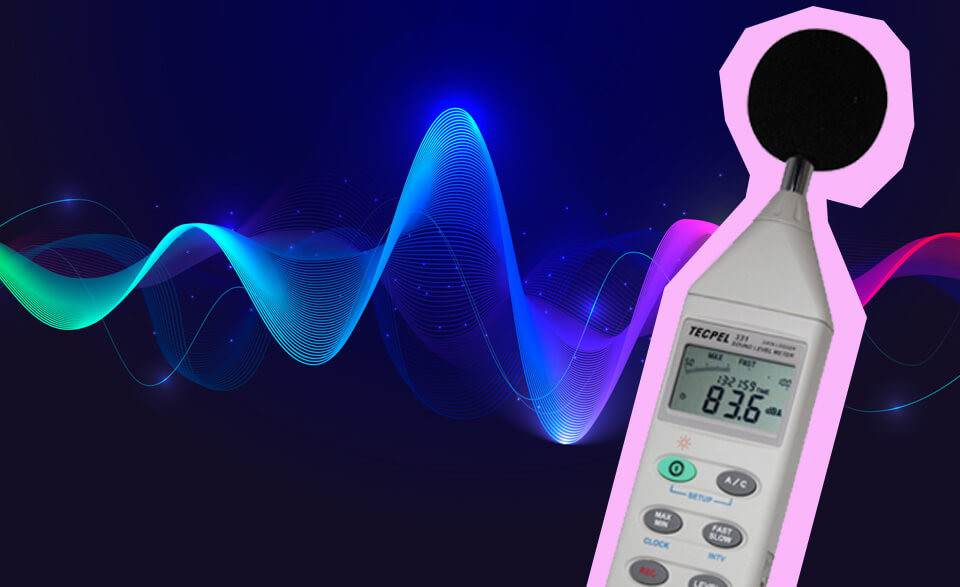Sound Level Meter (How It Works, Classes, Differences And Applications)
It may have happened to you that you were in a noisy factory and had to cover your ears or walked past a jackhammer in the street and winced because of the loud sound. Noise is the most common harmful factor in the workplace. Being exposed to loud noises for hours and days can affect the health of the workers and employees in the working environment and also other people and hearing damage may occur.
The first thing to help eliminate this problem is to measure how loud it is so the effective steps to be taken to reduce it.
Precise measurements of noise were quite a tricky business in the past, but today automated, electronic sound-level meters are available to do this job. Let's get a closer look!
Browse our wide selection of Sound Level Meter products category with the highest quality.
What is a Sound Level Meter?
A sound level meter (SLM) or sound meter is an electronic instrument to assess noise or sound levels produced by workplace machinery, alarm systems, speakers, and more by measuring sound intensity.
It is often known as a sound pressure level meter (SPL), decibel meter (dB meter), noise level meter (noise meter), or noise dosimeter.
It is simply a device with audio-frequency sensing ability that is basically controlled by a microcontroller. The microcontroller measures, compares, and takes the proper action (makes an audio announcement) to minimize noise level when reaching a critical sound level.
Noise meter makes it possible to determine whether the sound is within legal limits.
The sound level meter has the ability to measure the sound parameter in Decibels (dB) which is the standardized method of measuring loudness.

The Decibel scale is a logarithmic scale that is closer to how the human ear responds to loudness so it is suitable for doing this job.
It makes a more relevant scale for loudness in health and safety. The SLM is generally produced as handheld, portable devices.
Many manufacturers offer a wide range easy to use and compliant sound level meters for sale to suit your requirement.
What is the difference between SPL and loudness?
SPL or Sound Pressure Level is a measure of loudness. The unit of measurement is dB. Loudness is the measure of how much sound we can hear.
The difference between SPL and Loudness is that humans do not hear all frequencies at the same level and the closer to the source of the sound, you will hear more pressure. The far away you get from the source of the sound, the pressure will be less, but the loudness will be the same.
Is dB and dB SPL the same?
The decibel of SPL is a measurement of sound pressure levels in the air. It uses Pascals (Pa) as its unit of measurement but we convert it into the more popular decibel scale or dB scale.
SPL is measured with a Sound level meter. dB SPL is a standardized method of comparing the sound pressure levels of various sound events.
Why is monitoring noise in the workplace important?
Noise is considered one of the most common occupational health dangers that are often overlooked. It’s a risk in every industrial environment from production and mining to restaurants and farms.
Severe damage or permanent hearing loss are the main health concerns.
The noise levels in workplaces must be managed to avoid hearing damage. The best solution is to reduce noise with engineering controls.
When you cannot control the hazard, you need personal protective equipment (PPE) such as earmuffs or earplugs. Also, using instruments to monitor and report on the level of sound in the workplace is a proper choice.

How sound meters work
A typical meter is generally composed of a high-quality microphone, a preamplifier, a signal processor, and a display screen that displays noise results.
There is a pointy stick at the top of the device that is the microphone. Its function is to sample and measure the sound.

it picks up the sound and converts it into an electrical signal. To have a more accurate measurement, the stick keeps the microphone away from the body of the device and cuts out reflections.
Electronic circuits operate on this signal, measure the sound detected by the microphone and amplify and filter it in different ways.
Then a readout displays on a digital LCD display. The electronic circuit can be set to read the level of most frequencies in the measured sound or the intensity of selected bands of frequencies.
A usual sound-level meter can be switched between an unweighted scale that reads sound intensities uniformly for most frequencies and a scale that presents a frequency-dependent weighting factor, thus producing a response close to the human ear.
Different kinds of decibel meter (dB meter)
There are different kinds of decibel meters. The most primary ones make a reading of the maximum instantaneous sound pressure level (SPL), in decibels, at the time when you switch them on. It corresponds to how "loud" a noise sounds when you measure it.
If you want to measure the average sound levels over a period of time in somewhere like a noisy production factory, sound meter isn't always useful.
For that, you require a slightly more complex (and expensive) instrument called an integrating sound level meter. In this case, integrating means summing over a period of time.
For measuring sound levels over long periods of time, data logging meters are suitable that take measurements every so often. If you upload these measurements to a computer, drawing a chart shows how the sound level changes over the course of a day, week, or longer.
This kind of longer-term analysis is a fairer and more accurate method of detecting whether the sound is a nuisance than simply dependent on one or two instantaneous measurements.
What are the different types of sound meters?
Sound level meters are divided into four types of classes that vary widely in quality. The best ones that are worth using are designed to comply with international standards like IEC 60651, IEC 60804, and ANSI S1.4.
They are graded as type or class:
Type 0/ Class 0
Meters that have the highest standards are called type 0. These types are well suited for making high-precision measurements. For example, they can be used in a scientific laboratory.
Type 1/ Class 1
Type 1/Class 1 sound meters are slightly less accurate but used for high precision-grade assessments. They are most appropriate for use in laboratory testing.
Type 2/ Class 2
Type 2/Class 2 sound meters meet lesser standards and are less complex.
They are generally suitable for more general use, for noise level assessments in industrial, educational, commercial, or residential applications. These types are not really suitable for lab-quality measurements.
Type 3/ Class 3
Type 3 meters are also less accurate and only really proper for rough survey work or for producing preliminary measurements to know whether more accurate surveys are required with a type 0–2 meter. These meters are considerably less expensive.
What is the difference between a Class 1 and Class 2 sound level meter?
Often the question arises that what the difference between a Class 1 and Class 2 sound meter is, and which one meets your needs better?
The class system in sound level meter indicates the accuracy of the results given by the meter while measuring sound levels.
Class 1 has the ability to measure a wider sound frequency range and meet narrower tolerances for all performance criteria.
The result of this feature is a more accurate response for Class 1. So. So, we can say a Class 2 meter provides wider tolerances and is then slightly less accurate.
In other words, the Class 1 sound meter is called the ‘precision grade’ meter and is suitable for laboratory use, environmental applications, boundary noise, building acoustics, and traffic assessments.
While the Class 2 sound meter is called the ‘general grade’ meter and is well suited for use in Noise at Work assessments, basic environmental measurements, entertainment noise, industrial hygiene, construction noise, and vehicle noise. Also, Class 2 sound level meters are a lower cost in comparison to Class 1.
Why Use A Sound Level Meter?
Sound meters are well suited for measuring, monitoring, and controlling sound levels. They are used in different scenarios in factories and other industrial plants and construction sites.
Also, they are applicable in urban environments to monitor sound levels from the car, rail, and air traffic, public events, and other sources of sound.
Setting up audio equipment at concerts or for personal reasons are other environments where sound level meters can also be utilized.
For example, a sound meter in your home or workplace is used to avoid exposure to dangerous noise levels. It also is suitable for measuring sound pressure levels when calibrating audio equipment.
Digital Sound Level Meter
The Digital Sound Level Meter is a device used to accurately measure sound pressure levels. It is ideal for use in noise pollution studies for the quantification of almost any noise level, specifically for industrial and environmental noise.
The digital sound measurement provides a suitable measuring way for safety engineers, health, industrial safety offices, and sound quality engineers.
Applications for Sound Meter
Sound level meters are used in different applications where measurement and monitoring of sound levels are necessary.
Their general purpose is measuring noise, but they have the main role based on what environment they are used in. Here are a few examples of sound level meter applications that are valuable monitoring devices for numerous industries, including:
- Environmental and community assessments
- Occupational Noise Measurement
- Road & rail traffic
- Airports
- Hospital and Neonatal Noise
- Building acoustics
- Construction Site Noise
- Neighbor Noise
- Office and Call Center Noise
- Industrial noise
- Energy generation
- Hand Arm Vibration
- Music and Entertainment Noise
- System Integration and API
- Dust Monitoring
- Residential surveys
- Boundary noise surveys
- Vehicle noise evaluations
- Mobile equipment evaluations
- Machinery Noise Analysis
Questions
What is the influence of vibration on sound measurements?
When using a sound level meter next to vibration sources, it's better to protect the meter by mistreatment anti-vibration materials to have precise and reliable results.
Why we should calibrate a sound level meter?
If you’re measuring based on any Standard, Regulations, or Guidelines it is essential to calibrate your sound level meter. If not, you can not get the demanding accuracy of your measurements.
Will the meter lose its data when the battery runs out?
No, the data is saved in non-volatile memory. Therefore, it will not lose its data when the battery runs out.
What is the difference between occupational and environmental measuring?
Occupational monitoring is related to the noise exposure of employees but environmental monitoring is related to the impact of noise of operations or locations upon the surrounding environment.
If you want to read more here are the titles of articles which are useful for you:
Multimeter (Types, Applications, How to Choose)
Tachometer (Working Principle, Types, Applications)
Recent Posts
-
Booster Pump Troubleshooting and Maintenance: How to Fix and Prevent Common Issues
1. Introduction Imagine turning on your faucet only to be greeted with a weak trickle of water when …22nd Apr 2025 -
Energy-Efficient Booster Pumps: Selection and Tips for Maximizing Performance
1. Introduction Imagine never having to deal with fluctuating water pressure, noisy pumps, or skyroc …19th Apr 2025 -
Booster Pumps for Sustainable Water Systems: Irrigation and Rainwater Harvesting Solutions
1. Introduction Water scarcity is no longer a distant threat—it’s a reality affecti …16th Apr 2025




